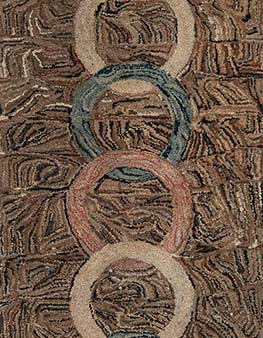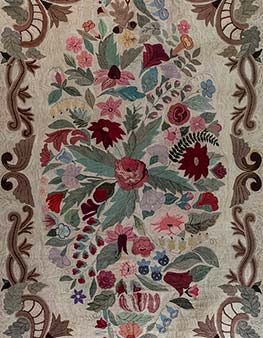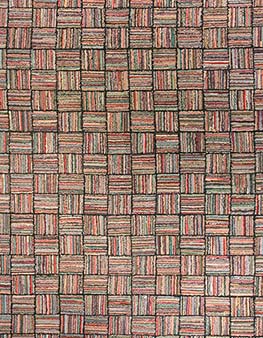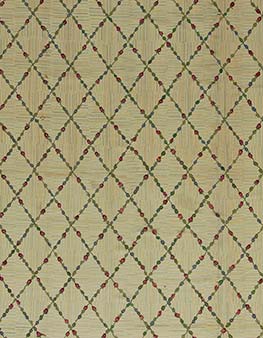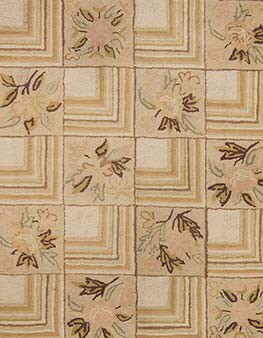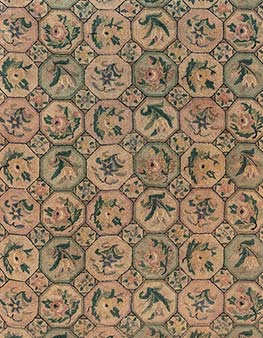The History of American Rugs
The history of American rugs has started around the 17th century with the arrival of the first settlers, but out of grave necessity rather than for decorative purposes. Harsh winters took a toll on the unprepared pioneers who did everything they could to keep themselves warm. Creating proper floor coverings that would not only act as space definers but, most importantly, as warmth bringers was the easiest way to improve their standards of living.
First American Rugs
First American rugs were the hooked ones and the so-called rag rugs. Both types are perfect examples of traditional recycling as they repurpose the used material scraps and fabric clippings, giving them a new life in the form of carpets. There is no need to point out that early American settlers had to be extremely resourceful. Wasting precious yarn, which has been applied for knitting and weaving, was out of question. Instead, the tradition of using all kinds of fabric remnants evolved and contributed to the creation of American rugs. The typical backing was made of burlap as it was in fact free of charge for the ones who purchased sacks with grain. These low-cost textiles made a huge impact on the lives of common American and nowadays are considered a paramount symbol of the American rug art. At first, making of hooked American rugs was considered solely the occupation of the poor. The craft was regarded as “country” in a derogatory sense and kept out of the higher-class concern until the beginning of the 20th century. Rich little girls were taught to embroider and quilt – fashioning of floor coverings was definitely not on the agenda. Even in the 19th, ladies magazines never mentioned anything about hooked rugs or rag rugs nor gave any advice on how to make them.
American Rugs as Important Folk Art in 20th Century
It wasn’t until the dawn of the 20th century that the craft of making American rugs started to be considered important folk art and spread all over the country, becoming one of the favorite pastimes of housewives, as well as the object of interest of renowned artists. Certainly, classic carpets have also quite early began to be produced in the United States. The vogue for floor coverings came around 1830 when factories started making machine-woven American rugs for the rich and wealthy. However, the hooked carpets and rag rags, along with the creations by Native Americans, such as Navajo rugs, are today synonymous with American rugs rather than any other type.
American rugs’ designs

American rugs’ designs started off humbly from utterly simple motifs. Antique American rugs consist mostly of geometric and floral patterns yet eventually they have evolved into something much more complex. Designs for American rugs were often inspired by the weaver’s natural environment and represented sea shells, fallen leaves, animals, the family dog, buildings, flowers, baskets, seascapes and landscape vignettes. From the early 1800’s through the middle years of the twentieth century these original compositions gave the rug makers an opportunity to freely express their creativity. Initially, the American society was composed of different nationalities, thus their artistic traditions and techniques mixed freely resulting in original creations. In the 1870s, Edward Sands Frost came up with the idea of printing the designs from stencils made of old copper boilers. His idea took the market by storm, however, the mass production initiated the decline in the quality of rugs as well as their popularity. Braided American rugs were just as common and appeared as another way to utilize bits and pieces of textiles.
Native Americans Rugs
As mentioned before, American rugs were not only made by the European settlers. Native Americans poses their own way of carpet making. While wool was introduced to Native Americans by Spaniards in the 16th century, there are proofs that Indians had been weaving rugs long time before the colonization. American Indian Rugs (i.e. Navajo rugs) are a well-known, extremely sought-after type of flat-woven textiles, often synonymous with American rugs. They are distinguished by simple yet pronounced and striking geometric patterns and natural dies which gave mostly natural brown, white, and indigo colors, with the latter obtained through trade and purchased in lumps. Their strongest side, however, is the exceptional quality which, according to some experts, equals the delicacy and sophistication of any pre-mechanical loom-woven carpets and can be compared to Scandinavian rollakans or Turkish kilims. These mesmerizing American rugs continue to capture imagination and constitute a reminder of the spiritual and nature-oriented reign of Native Americans on the New Continent.
Nowadays…
Today American rug industry develops quickly, delivering us new pieces every day. Although the craft of making traditional hooked rugs is still well and alive, and Navajo people continue to weave for commercial purposes, the USA designers experiment with patterns, colors and fibers, often surprising carpet aficionados with their creative approach. High quality American rugs are praised all over the world, making country’s weaving industry one of the most influential in the world.
